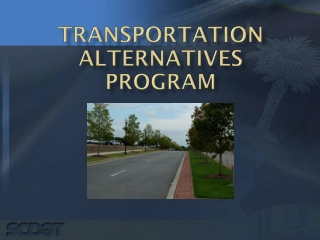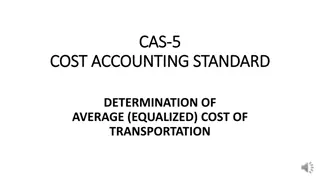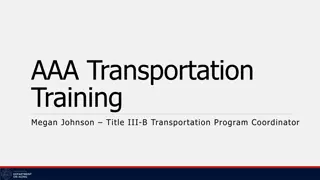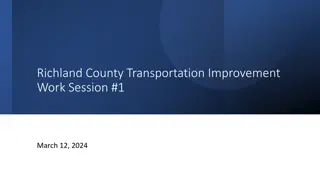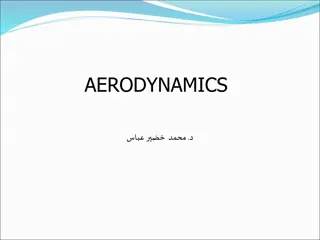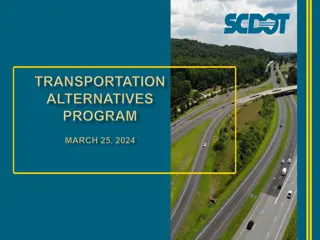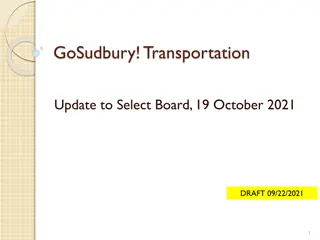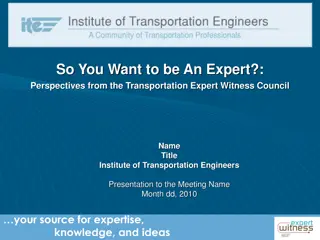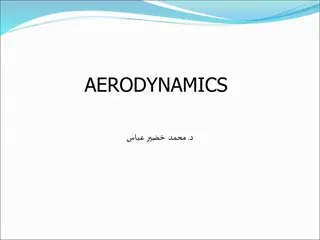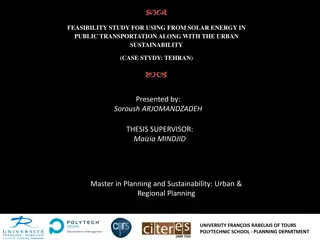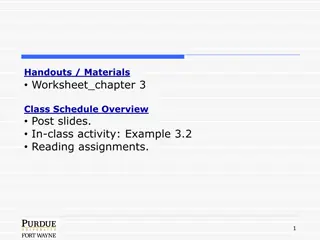Importance of Aerodynamics in Transportation Design
Aerodynamics is a crucial aspect of vehicle design that impacts operating efficiencies. Manufacturers must balance aerodynamics with styling and ergonomics to appeal to consumers. Traditionally, wind tunnel testing was vital, but modern advancements in CAD have shifted testing later in the design process. Careful consideration of aerodynamic factors can significantly enhance vehicle performance and efficiency.
Download Presentation

Please find below an Image/Link to download the presentation.
The content on the website is provided AS IS for your information and personal use only. It may not be sold, licensed, or shared on other websites without obtaining consent from the author.If you encounter any issues during the download, it is possible that the publisher has removed the file from their server.
You are allowed to download the files provided on this website for personal or commercial use, subject to the condition that they are used lawfully. All files are the property of their respective owners.
The content on the website is provided AS IS for your information and personal use only. It may not be sold, licensed, or shared on other websites without obtaining consent from the author.
E N D
Presentation Transcript
MK PILIHAN TRANSPORTATION DESIGN
Aerodynamics is a highly refined science that vies for position with other key vehicle design considerations such as styling and ergonomics. It's importance with respect to the operating efficiencies of a vehicle is undisputed but manufacturers must steer a balanced path between the push an pull of the many other aspects of a car necessary to sell it to the consumer. Aerodynamics started life as much as an art as a science. Early experiments used fish as the inspiration. Their sleek form was considered important to facilitate fast movement, but the precise details were not yet understood and developments were largely based on trial and error. It was as a result of this approach that the 'teardrop' form was conceived.
Traditionally, wind tunnel testing was a sizeable trial and error process, ongoing throughout the development of a vehicle. Today, with the high level of CAD prediction and pre-production evaluation, coupled with a greater human understanding of aerodynamics, wind tunnel testing often comes into the design process later. The wind tunnel is the proving ground for the vehicle's form and allows engineers to obtain considerable amounts of advanced information within a controlled environment. Whilst advanced design processes can anticipate a large proportion of aerodynamic performance, it is still crucial to assess a vehicle in the wind tunnel. Many elements of a vehicle's form only reveal their behaviourin air flow when carefully tested and cannot be anticipated on computer. The reality of production, tolerances in components and accuracy of build can all play a part in affecting the aerodynamic behaviourof a car. Aside from engineering concerns, manufacturers are increasingly looking to see how to improve the customer- side of aerodynamics. For example, wind noise from door mirrors is considered very undesirable and can only really be evaluated in a wind tunnel. Other, less obvious issues can also be examined -such as whether air flow forces water through seals or dirt into door apertures.
In this photograph, a stream of smoke travels over the vehicle in the wind tunnel as air passes from right to left. It can be clearly seen that laminar air flow remains attached until the very rear of the vehicle, emphasisingjust how carefully aerodynamic performance has been considered.
Aerodynamic factors, considered carefully, can improve many aspects of a vehicle. Some key aerodynamic considerations have been summarisedhere. [(vi) refers to Road Vehicle Aerodynamic Design by R.H. Barnard] With an object moving through a fluid, the wake is extremely significant. When considering family vehicles, the nature of the vehicle s rear, in three dimensions, can make the difference between a low or a high coefficient of drag (Cd). Improvements at the front can be made by ensuring the front end is made as a smooth, continuous curve originating from the line of the front bumper . On normal two and three box shapes, drag is often caused by high pressure just upstream of the front windscreen, often with a separation bubble of recirculating air at the base of the screen . The magnitude of this effect depends upon the windscreen rake angle . Making the screen more raked (ie. not as upright) tends to reduce the pressure at the base of the screen, and to lower the drag . However, much of this improvement arrives because a more sloped screen means a softer angle at the top where it meets the roof, keeping flow attached. Similar results can be achieved through a suitably curved roof. Design in plan as well as profile, is significant. Curving the windscreen in plan view modifies the flow patterns considerably ... which reduces the extent and intensity of high pressure.
The A-post is also an issue: A strong outward cross-flow can occur towards the edges of the windscreen, tending to produce separated vortices around the A- posts. These effects can be minimisedby smoothing the form of the A-post and increasing the curvature of both the A-post and the screen. Smoothing the transition from the body to door mirror is also significant as it can otherwise be a major source of drag and wind noise. At the rear of vehicles, the ideal format is a long and gradual slope. As this is not practical, it has been found that raising and/or lengthening the boot generally reduces the drag . Results of research state that drag due to rear slope angle will be at its peak at 30 and minimum at around 10 . Increasing the curvature of the roofline will also reduce the drag coefficient. Benefits are gained by bringing the roof line down at the front and rear. Simply bulging the roofline up however, may cause such an increase in frontal area that any gains may be negated.
In plan view, rounding corners and all forward facing elements will reduce drag. Increases in curvature of the entire vehicle in plan will usually decrease drag provided that frontal area is not increased. Tapering the rear in plan view , usually from the rear wheel arch backwards, can produce a significant reduction in drag . Under the vehicle, a smooth surface is desirable as it can reduce both vehicle drag and surface friction drag. For a body in moderate proximity to the ground, the ideal shape would have some curvature on the underside. In (vi), the author lists the following significant areas for thought when attempting to design a typical car (not a sports car or commercial vehicle): Smooth unbroken contours with favourablepressure gradients as far back as practical should be used. Strongly unfavourablepressure gradients at the rear should be avoided; some taper and rear end rounding should be used. The form should produce negligible lift.
A If a hatchback configuration is required, the backlight angle should not be in the region of 30, and if a notchback (saloon) is to be used, the effective slope angle (ie. the angle of a direct line between the roof and the highest, most rearward point) should also not be in the region of 30 . The underbody should be as smooth and continuous as possible, and should sweep up slightly at the rear, There should be no sharp angles (except where it is necessary to avoid cross-wind instability). The front end should start at a low stagnation line, and curve up in a continuous line. The front screen should be raked as much as is practical. All body panels should have a minimal gap. Glazing should be flush with the surface as much as possible. All details such as door handles should be smoothly integrated within the contours. Excrescences should be avoided as far as possible; windscreen wipers should park out of the airflow. Minor items such as wheel trims and wing mirrors should be optimised using wind-tunnel testing. The cooling system needs to be designed for low drag. Although aerodynamic concerns are not as strong in this vehicle as they may be in a sports car, for example, the basic principles outlined here should be observed throughout the design process. Energy efficiency can be improved with low drag and low levels of wind noise improve passenger comfort.


